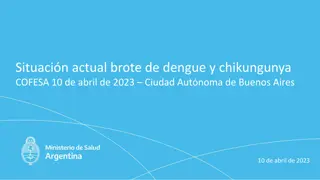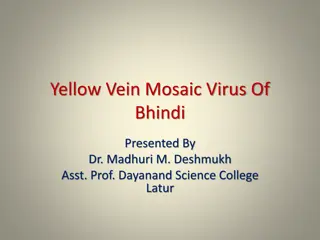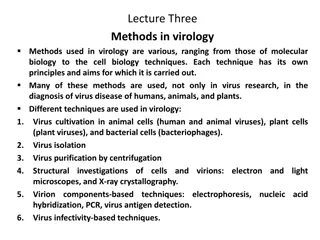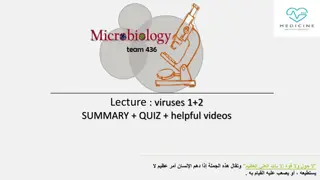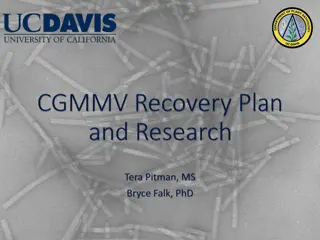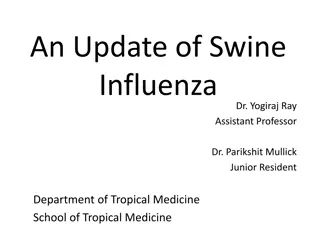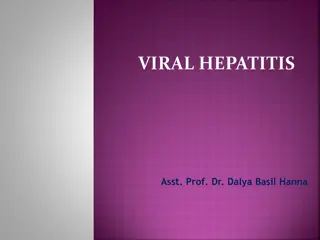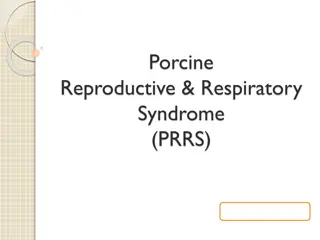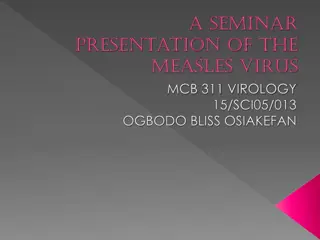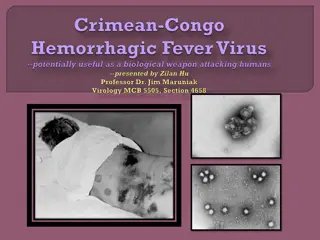Understanding Chikungunya Virus: Symptoms, Transmission, and Diagnosis
Chikungunya virus, derived from the Makonde language, causes sudden onset of high fever, joint pain, rash, and other symptoms. It is transmitted by Aedes mosquitoes and can result in debilitating joint pain. Diagnosis involves clinical evaluation and laboratory tests for confirmation.
Download Presentation

Please find below an Image/Link to download the presentation.
The content on the website is provided AS IS for your information and personal use only. It may not be sold, licensed, or shared on other websites without obtaining consent from the author. Download presentation by click this link. If you encounter any issues during the download, it is possible that the publisher has removed the file from their server.
E N D
Presentation Transcript
Chikungunya Vandana Gupta Medical Microbiology Semester VI
The word 'chikungunya' is believed to have been derived from a description in the Makonde language, meaning "that which bends up", The disease was first described in 1955, following an outbreak in 1952 on the Makonde Plateau, along the border between Mozambique and Tanganyika (the mainland part of modern- day Tanzania). Since its discovery in Tangania, Africa, in 1952, Chikungunya virus outbreaks have occurred occasionally in Africa, South Asia, and Southeast Asia, but recent outbreaks have spread the disease over a wider range. Biological weapon Chikungunya is one of more than a dozen agents researched as a potential biological weapon.
Etiology and transmission Chikungunya virus (CHIKV), genus Alphavirus, family Togaviridae: RNA virus with a +ve-sense ss genome of about 11.6kb It was first isolated in 1953 in Tanzania It is a member of the Semliki Forest virus complex and is closely related to Ross River virus referred to as an arbovirus (arthropod-borne virus). In the United States, it is classified as a category C priority pathogen, and work requires biosafety level III precautions. Transmission Mosquito Aedes to humans. Less commonly from mother to child during pregnancy or at birth. A. aegypti being most common vector, though other species eg A. albopictus : also reported IP: 1-12 d, (avr 3-7D) Rarely asymptomatic, 72% to 97% of those infected will develop symptoms
symptoms sudden onset with high fever, usually above 39 C (102 F) to 40 C (104 F) joint pain, and rash. may include headache, fatigue, digestive complaints, and conjunctivitis Usually has an acute and a chronic phase. acute phase with two stages: a viral stage during the first 5-7 days, during which viremia occurs, followed by a convalescent stage lasting approx 10 days: symptoms improve and the virus cannot be detected in the blood. Typically, the disease begins with a sudden high fever lasting a week to ten days. the level of virus in the blood correlates with the intensity of symptoms in the acute phase. Following the fever, strong joint pain or stiffness occurs; it usually lasts weeks or months, or years. The joint pain can be debilitating, often resulting in near immobility of the affected joints, most commonly peripheral joints, such as the wrists, ankles, and joints of the hands and feet as well as other joints Rash occurs in 40 50% of cases, generally as a maculopapular rash occurring two to five days after onset of symptoms. Digestive symptoms, including abdominal pain, nausea, vomiting or diarrhea, may also occur. Rarely, neurological disorders: including palsies, meningo-encephalitis, flaccid paralysis and neuropathy. Unlike dengue fever, Chikungunya fever very rarely causes hemorrhagic complications.
Diagnosis diagnosed on the basis of clinical, epidemiological, and laboratory criteria. Clinically, acute onset of high fever and severe joint pain would lead to suspicion of chikungunya. decreased lymphocyte count consistent with viremia : presumptive. Definitive diagnosis viral isolation, RT-PCR, or serological diagnosis. Virus isolation provides the most definitive diagnosis, but takes one to two weeks for completion and must be carried out in biosafety level III laboratories. RT-PCR using nested primer pairs is used to amplify several chikungunya-specific genes from whole blood, Serological diagnosis: IgM ELISA detectable from 5 days to months after the onset of symptoms,
Prevention no approved vaccine yet, protection against contact with the disease-carrying mosquitoes and controlling mosquito populations eliminating the standing water where mosquitos lay eggs and develop as larva; Use of insecticides or biological control agents can be added. insect repellents However, increasing insecticide resistance presents problem Wearing bite-proof long sleeves and trousers, securing screens on windows and doors A phase-II vaccine trial used a live, attenuated virus, to develop viral resistance in 98% but 8% of people reported transient joint pain, and attenuation was found to be due to only two mutations in the E2 glycoprotein. National Institute of Allergy and Infectious Diseases (USA): virus-like particles (VLPs) vaccineuated virus. Phase1 results : good, further trials going on
Treatment Currently, no specific treatment available. Supportive care is recommended, and symptomatic treatment of fever and joint swelling includes the use of nonsteroidal anti- inflammatory drugs and paracetamol and fluids. Aspirin is not recommended due to the increased risk of bleeding. Passive immunotherapy benefit in treatment of chikungunya. In those who have more than two weeks of arthritis, ribavirin may be useful. The effect of chloroquine is not clear. It does not appear to help acute disease, but tentative evidence indicates it might help those with chronic arthritis.



